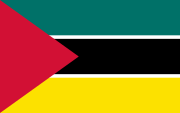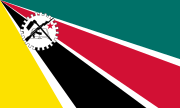Flag of Mozambique
 | |
| Use | National flag and ensign |
|---|---|
| Proportion | 2:3 |
| Adopted | 1 May 1983 |
| Design | A horizontal tricolour of green, black, and gold with white fimbriations and a red isosceles triangle at the hoist. The triangle is charged with a five-pointed gold star which has above it an AK-47 crossed by a hoe, superimposed on an open book. |
| Designed by | FRELIMO |
The national flag of Mozambique is a horizontal tricolour of green, black, and gold with white fimbriations and a red isosceles triangle at the hoist. The triangle is charged with a five-pointed gold star in its center, above which there is an AK-47 crossed by a hoe, superimposed on an open book. The current design, adopted on 1 May 1983, is a modified version of the first flag of FRELIMO (Mozambique Liberation Front), which has governed the country since its independence from Portugal on 25 June 1975. Since the democratisation of Mozambique in 1990, there have been calls to change the flag, particularly to remove the AK-47.
Design and symbolism
[edit]The design of the flag is described in Title XVI, Article 297 of the Constitution of Mozambique, 2004 (2007 revision):[1]
"From top to bottom, there shall be green, black, and gold horizontal stripes, separated by strips of white. On the left side, there shall be a red triangle, in the center of which there shall be a star. Above this there shall be a crossed hoe and gun, superimposed on a book."
The constitution also explains the significance of the flag's colours and symbols. Red represents anti-colonial resistance and the defence of national sovereignty; green and gold represent the riches of the country's soil; black represents the African continent, and white represents peace and the justness of the Mozambican people's struggle. The star represents the international solidarity of the Mozambican people, while the book, hoe, and gun symbolise education, production, and defence, respectively.[1] While the constitution does not identify the specific gun used in the design, it is generally understood to be an AK-47 with a bayonet attached.[2][3][4] The flag of Mozambique is one of two national flags that feature a firearm, the other being the flag of Guatemala.[5] It is the only national flag that features a modern firearm.[6]
The US Central Intelligence Agency's World Factbook gives a slightly different explanation of the flag's symbolism. It states that yellow represents Mozambique's minerals, the star represents Marxism and internationalism, the gun represents vigilance in addition to defence, the hoe represents agriculture, and the open book stresses the importance of education.[5]
Historical flags
[edit]During the Portuguese colonial period, Mozambique flew the Portuguese flag.[7] The Mozambican War of Independence between Portugal and FRELIMO ended in September 1974 with the signing of the Lusaka Accord and the formation of a transitional government.[8] During Mozambique's transition to independence, the flag of Portugal flew alongside the then flag of FRELIMO, which was similar to the country's current flag but without any charges on the triangle.[9][10] American vexillologist Whitney Smith suggests that the design may have been inspired by the flag of Tanganyika, where FRELIMO had been operating in exile.[9]
The People's Republic of Mozambique proclaimed its independence on 25 June 1975, and a new national flag was hoisted in place of the Portuguese and FRELIMO flags.[9][11] The new flag's design was defined in Title IV, Article 68 of the Constitution of the People's Republic of Mozambique. The flag consisted of four diagonal stripes emanating from the upper hoist, separated by white fimbriations. The stripes were, from top to bottom, green, red, black, and yellow. Near the upper hoist was a white cogwheel, charged with a red star and an AK-47 crossed by a hoe, superimposed on an open book.[12] The colours and symbols of the People's Republic flag retained by the current flag share the same meaning. The cogwheel represented the working class and industrial production, while the red star represented internationalism.[12] The flag was altered in April 1983; the green, black, and yellow stripes were rearranged horizontally, a red triangle was added at the hoist, and the star was enlarged and place behind the cogwheel. The cogwheel was removed shortly thereafter on 1 May 1983, leading to the flag's present design.[10]
Proposals to change the flag
[edit]
The drafting of a new Mozambican constitution in 1990 started discussions on changing the country's national symbols, including the national flag.[13] Critics argued that, because the national flag resembled the flag of FRELIMO, it was antithetical to calls for national unity.[14] Jorge Rebelo, a member of FRELIMO's political bureau, acknowledged the debates surrounding the flag but stated that it would remain unchanged.[13] Since then, the primary criticism has been directed at the inclusion of the AK-47 on the flag, which some Mozambicans view as an allusion to violence.[14]
In 2005, the Mozambican government held a competition to design a new national flag and emblem. RENAMO (Mozambican National Resistance), Mozambique's main opposition party, called for the removal of the AK-47 and star from the flag. José Gabriel Manteigas, a RENAMO member of parliament, gave the following critique:[15]
"As a peaceful country, you can't have a flag with a gun on it. For children growing up now in peace, they see a flag with a gun on it, and it doesn't make sense. As for the star, anyone who has seen the Soviet flag knows that a star is the mark of communism. It is true that the Mozambique flag's yellow star seems borrowed from an earlier Frelimo flag with a crossed hammer and hoe under a yellow star, a blood relative of the old Soviet hammer and sickle."
Then Mozambican president Joaquim Chissano responded by saying that, if Mozambique's lone star symbolised communism, then "the Stars and Stripes would place the United States among the world's most leftist nations."[15] A total of 169 entries were received and reviewed by a panel of five judges.[15] The proposals were ultimately rejected by the Assembly of the Republic, which voted 155 to 79 against changing the flag. All the votes against were from FRELIMO, and all the votes for were from RENAMO.[16]
References
[edit]Citations
[edit]- ^ a b Constitution of the Republic of Mozambique 2007, p. 97, Title XVI, Article 297.
- ^ Encyclopædia Britannica 2024: "The symbolic value of the AK-47 to such movements is demonstrated by its presence on the coats of arms of numerous countries as well as on the flag of Mozambique."
- ^ Chivers 2011, p. 15: "An AK-47 with bayonet attached appears on the flag of Mozambique ..."
- ^ Wheeler 1990, p. 161: "Samora Machel, who declared the country's name as the People's Republic of Mozambique and placed a depiction of a Soviet AK47 Kalashnikov on the national flag."
- ^ a b Central Intelligence Agency 2024.
- ^ Marshall 2017, p. 73: "The single most interesting thing about it is the AK-47 assault rifle with a fixed bayonet on its left-hand side. This is the only national flag in the world with a modern weapon symbolised on it."
- ^ Mohr 1975.
- ^ Munslow 1988, p. 25.
- ^ a b c Smith 2001.
- ^ a b Flag Research Center 1983, p. 242.
- ^ Zeman 2024, p. 248.
- ^ a b Constitution of the People's Republic of Mozambique 1975, Title IV, Article 68.
- ^ a b Seleti 1997, p. 57.
- ^ a b Marshall 2017, p. 73.
- ^ a b c Wines 2005.
- ^ Reuters 2005.
Sources
[edit]Books
[edit]- Chivers, C. J. (6 September 2011). The Gun. Simon and Schuster. ISBN 978-0-7432-7173-8.
- Marshall, Tim (4 July 2017). A Flag Worth Dying For: The Power and Politics of National Symbols. Simon and Schuster. ISBN 978-1-5011-6835-2.
- The Flag Bulletin. Vol. 22. Flag Research Center. 1983.
- Wheeler, Jack (1990). "Mozambique". In Radu, Michael (ed.). The New Insurgencies: Anti-Communist Guerrillas in the Third World (1st ed.). Transaction Publishers. ISBN 978-1-4128-3800-9.
Journal articles
[edit]- Munslow, Barry (1988). "Mozambique and the Death of Machel". Third World Quarterly. 10 (1): 23–36. ISSN 0143-6597.
- Seleti, Yonah (January 1997). "The transition to democracy and the production of a new national identity in Mozambique". Critical Arts. 11 (1–2): 46–62. doi:10.1080/02560049785310061. ISSN 0256-0046.
- Zeman, Andreas (9 May 2024). "Flag Independence without Flags? Mozambican Decolonization on the Periphery of the New Nation". e-Journal of Portuguese History. 21 (2): 246–267. doi:10.1163/16456432-20040005.
News articles
[edit]- "Are you passionate about your flag?". BBC News. 23 December 2005. Archived from the original on 24 December 2005.
- Mohr, Charles (25 June 1975). "Mozambique Independent Of Lisbon After 470 Years". The New York Times.
- "Mozambique: Parliament Keeps Gun In National Flag". Reuters. 20 December 2005 – via The New York Times.
- Wines, Michael (7 October 2005). "Symbols Are Important. So What Does a Gun Symbolize?". The New York Times. Archived from the original on 29 May 2015.
Government publications
[edit]- "Constituição da República Popular de Moçambique" [Constitution of the People's Republic of Mozambique] (PDF) (in Portuguese). Maputo: Government of the People's Republic of Mozambique. 20 June 1975. Archived from the original (PDF) on 3 June 2019.
- "Constitution of the Republic of Mozambique" (PDF). Translated by MOZLEGAL. Maputo: Government of the Republic of Mozambique. 2007.
Websites
[edit]- "AK-47". Encyclopædia Britannica. Encyclopædia Britannica, Inc. 18 July 2024.
- "Mozambique". The World Factbook. Central Intelligence Agency. 30 July 2024.
- Smith, Whitney (16 February 2001). "Flag of Mozambique". Encyclopædia Britannica. Encyclopædia Britannica, Inc.
External links
[edit] Media related to Flags of Mozambique at Wikimedia Commons
Media related to Flags of Mozambique at Wikimedia Commons- Mozambique at Flags of the World



